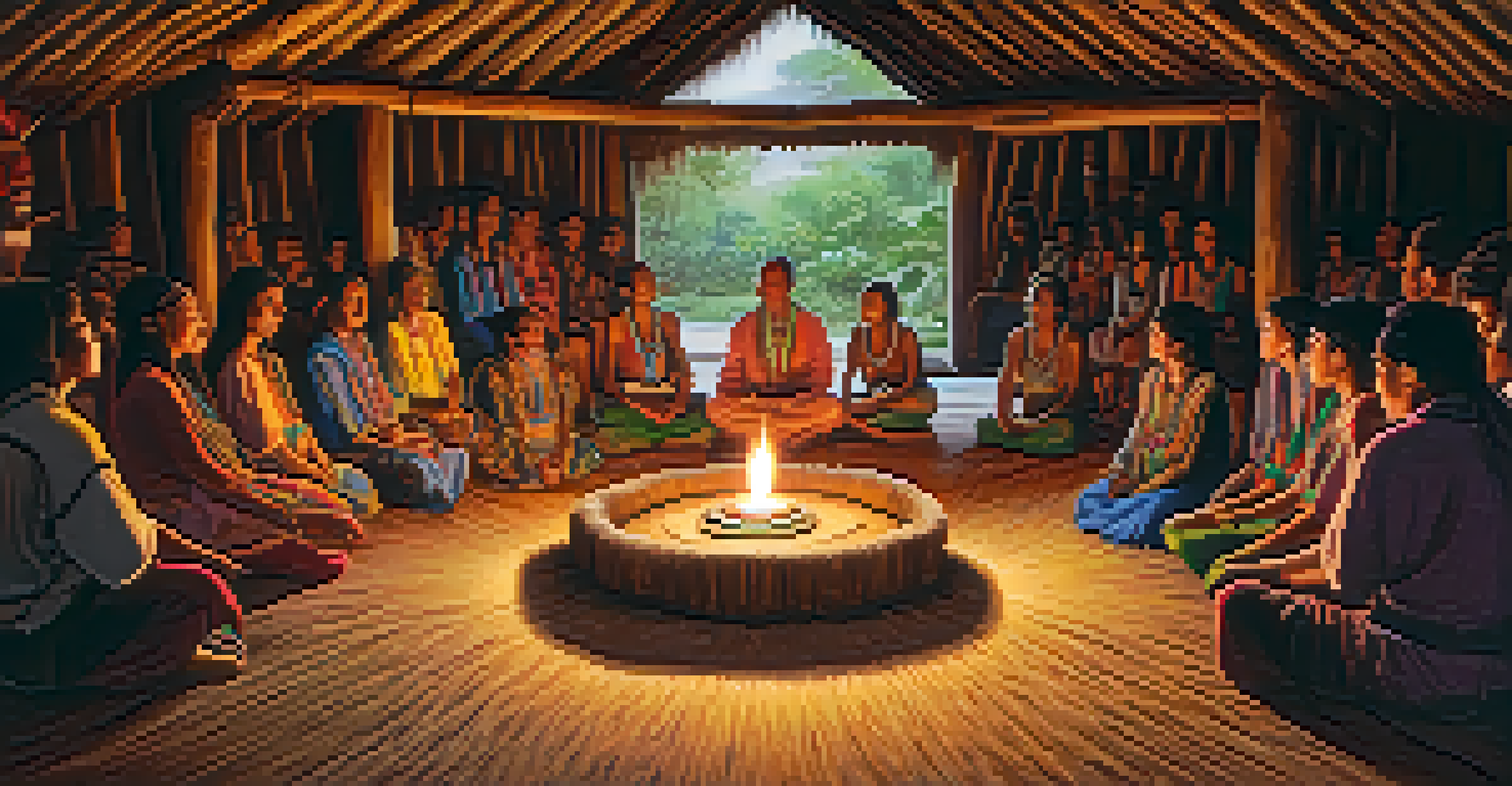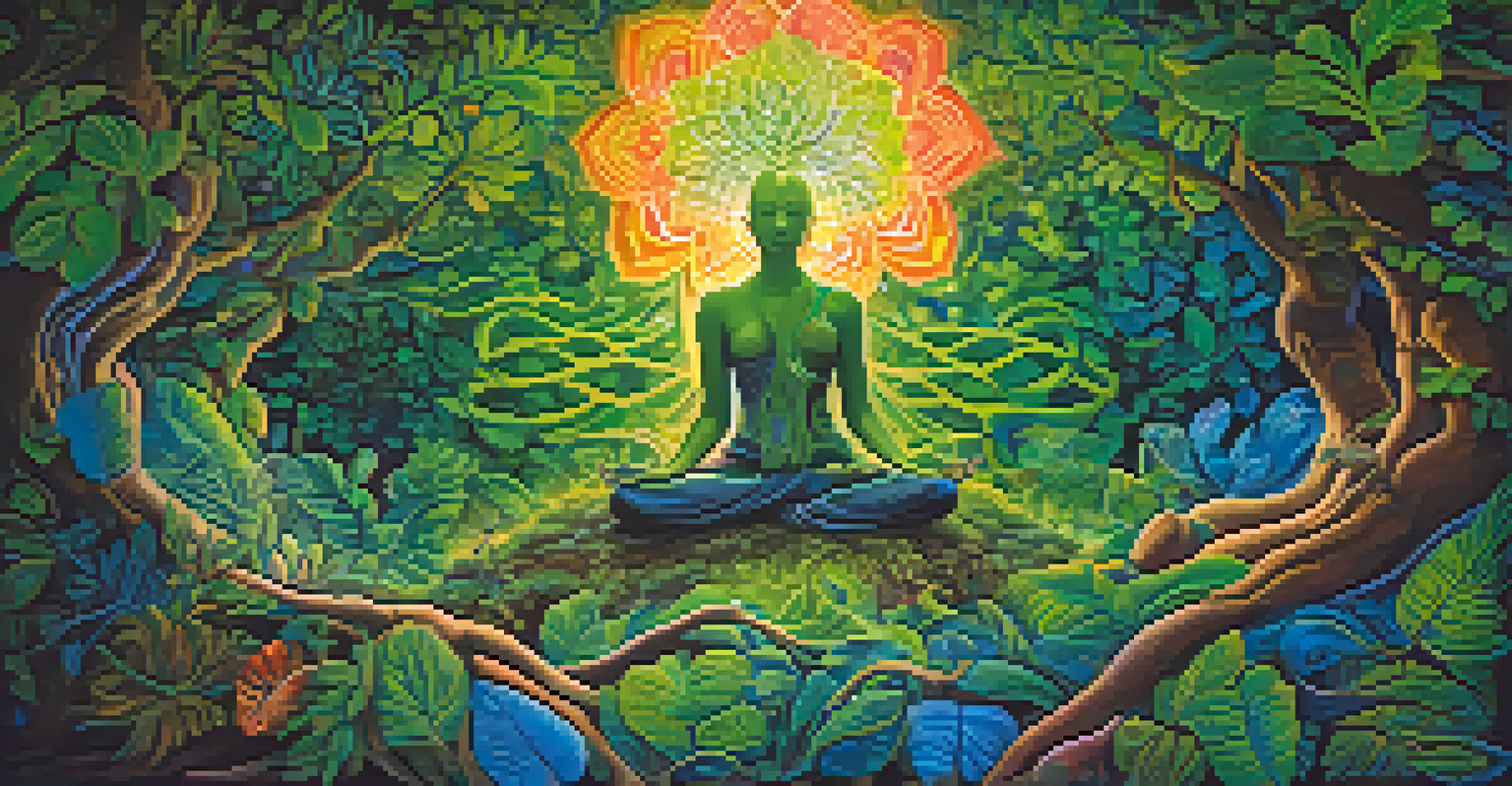The Influence of Ayahuasca in Peruvian Shamanic Practices

Understanding Ayahuasca: A Sacred Brew
Ayahuasca, a traditional Amazonian brew, is made from the Banisteriopsis caapi vine and other plants. This powerful concoction has been used for centuries by indigenous tribes in Peru for spiritual and healing practices. It’s not just a drink; it’s a gateway to deep introspection and connection with the spiritual world.
Ayahuasca is a bridge to the spiritual world, allowing us to connect deeply with ourselves and nature.
The brew's active compounds, particularly DMT (dimethyltryptamine), are believed to facilitate visions and profound insights. Users often describe experiences that lead to personal revelations and a sense of oneness with nature. This transformative nature positions Ayahuasca as a vital tool in shamanic rituals.
In the hands of experienced shamans, Ayahuasca becomes a medium for healing both psychological and physical ailments. The shaman's role is crucial as they guide participants through the experience, ensuring safety and providing context to the visions encountered.
The Role of Shamans in Ayahuasca Ceremonies
Shamans, or 'curanderos,' hold a revered place in Peruvian culture, particularly during Ayahuasca ceremonies. They are seen as spiritual guides, bridging the gap between the physical and spiritual realms. Their extensive training and experience allow them to facilitate profound healing experiences for participants.

During a ceremony, the shaman invokes sacred songs called 'icaros' that are believed to summon spirits and set the tone for the experience. These songs help participants navigate their journey, offering comfort and guidance when needed. The shaman's presence is both protective and transformative, ensuring that the ceremony unfolds as intended.
Ayahuasca as a Healing Tool
Ayahuasca is revered for its potential to aid in mental health healing and personal transformation through guided ceremonies.
The relationship between the shaman and the participants is built on trust and respect. This dynamic is essential, as the vulnerable nature of the Ayahuasca experience requires a safe environment, where individuals can openly explore their fears and emotions.
Ayahuasca's Healing Properties in Shamanic Practices
Many participants seek Ayahuasca for its reputed healing properties, particularly for mental health issues like depression and anxiety. Research suggests that the brew may help reset neural pathways, offering a fresh perspective on emotional struggles. This aligns with traditional beliefs held by shamans about the brew's ability to cleanse and heal.
In the journey of Ayahuasca, we confront our fears and traumas, paving the way for healing and transformation.
In a shamanic context, healing often involves confronting and integrating past traumas. This process can be intensely cathartic, leading to a sense of liberation and emotional release. By addressing these issues, participants often report lasting positive changes in their mental and emotional well-being.
Moreover, the communal aspect of the ceremonies fosters a sense of belonging and connection among participants. Sharing experiences with others can amplify the healing process, reinforcing the idea that one is not alone in their struggles.
The Symbolism of Ayahuasca in Shamanic Lore
Ayahuasca is steeped in rich symbolism within the context of shamanic lore. Many indigenous cultures view the brew as a teacher, offering wisdom and insights that transcend ordinary understanding. This perception elevates Ayahuasca from a mere substance to a sacred entity that demands respect.
In various traditions, the visions experienced during Ayahuasca ceremonies are interpreted as messages from the spirit world. These messages often provide guidance on one’s life path or reveal hidden truths about oneself. Such insights are not only valued for personal growth but also for their potential to benefit the wider community.
Shamans' Role in Ceremonies
Shamans act as spiritual guides during Ayahuasca ceremonies, invoking sacred songs and ensuring a safe environment for participants.
The symbolism associated with Ayahuasca also reflects the interconnectedness of all living beings. Shamans teach that the experiences gained during these ceremonies can lead to a deeper understanding of nature and humanity’s role within it.
Cultural Significance of Ayahuasca in Peru
Ayahuasca is not just a substance; it embodies the cultural heritage of Peruvian indigenous communities. Its use signifies a profound connection to ancestral traditions and spiritual practices that have been passed down through generations. In this way, Ayahuasca serves as a cultural touchstone, linking the past with the present.
The revival and growing popularity of Ayahuasca ceremonies among tourists have sparked discussions about cultural appropriation and sustainability. While many seek authentic experiences, it’s crucial to approach these practices with respect and understanding of their origins. Acknowledging the cultural significance of Ayahuasca can help preserve its legacy.
Moreover, the global interest in Ayahuasca has opened up opportunities for indigenous communities to share their traditions while generating income. This can lead to a revitalization of cultural practices, but it also raises questions about commercialization and the potential dilution of authentic experiences.
Challenges and Risks of Ayahuasca Use
While Ayahuasca offers numerous benefits, it is essential to acknowledge the challenges and risks associated with its use. Not everyone is suited for the intense experiences that Ayahuasca can provoke, particularly individuals with certain mental health conditions. Therefore, proper screening and guidance are crucial before participating in ceremonies.
Additionally, the setting in which Ayahuasca is consumed plays a significant role in the overall experience. Unsafe or poorly managed environments can lead to distressing experiences, sometimes referred to as 'bad trips.' Participants should prioritize finding reputable shamans and centers to ensure a safe and supportive atmosphere.
Cultural Significance in Peru
Ayahuasca represents a vital cultural heritage for indigenous communities in Peru, linking ancestral traditions to contemporary practices.
Lastly, the increasing popularity of Ayahuasca has led to a proliferation of ceremonies, some of which may lack the necessary cultural understanding or respect. It’s vital for seekers to educate themselves about these practices to ensure they engage with authenticity and integrity.
The Future of Ayahuasca in Shamanic Practices
As interest in Ayahuasca continues to grow, its future in shamanic practices is both promising and complex. There’s a potential for further integration of traditional knowledge and modern therapeutic practices, paving the way for Ayahuasca to be recognized in broader contexts. This could lead to new research opportunities and the development of safe practices.
However, this growing interest must be balanced with respect for the indigenous cultures that have preserved these traditions for centuries. Ensuring that these communities benefit from the dialogue surrounding Ayahuasca is crucial. It fosters a relationship that honors their contributions while promoting sustainability.

Ultimately, the future of Ayahuasca in shamanic practices will depend on how it is approached by both practitioners and seekers. By prioritizing respect, education, and ethical considerations, Ayahuasca can continue to be a powerful tool for healing and spiritual growth.